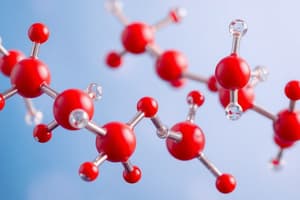Podcast
Questions and Answers
What is the primary function of glycolipids in the membrane?
What is the primary function of glycolipids in the membrane?
- Act as channels for substance transport
- Assist in cell-cell interactions (correct)
- Provide structural support to the lipid bilayer
- Serve as receptors for hormone binding
Which type of glycosylation is associated with serine amino acids?
Which type of glycosylation is associated with serine amino acids?
- S-linked glycosylation
- C-linked glycosylation
- N-linked glycosylation
- O-linked glycosylation (correct)
Which characteristic is true for both integral and peripheral proteins?
Which characteristic is true for both integral and peripheral proteins?
- Both are involved in transport functions
- Both can act as enzymes
- Both provide specificity to a membrane (correct)
- Both are embedded in the lipid bilayer
Which component of the membrane is primarily responsible for repelling other molecules due to charge?
Which component of the membrane is primarily responsible for repelling other molecules due to charge?
What role do proteoglycans play in the cell membrane?
What role do proteoglycans play in the cell membrane?
What role do polysaccharides primarily serve in organisms?
What role do polysaccharides primarily serve in organisms?
Which of the following best describes the composition of lipoproteins?
Which of the following best describes the composition of lipoproteins?
Which statement accurately describes the structure of proteins?
Which statement accurately describes the structure of proteins?
What is the main function of triglycerides in the human body?
What is the main function of triglycerides in the human body?
Which of the following statements about carbohydrates is correct?
Which of the following statements about carbohydrates is correct?
Flashcards are hidden until you start studying
Study Notes
Macromolecules of Life
- Four primary types: carbohydrates, proteins, lipids, nucleic acids.
- Polymers are formed by dehydration synthesis and broken down by hydrolysis.
Carbohydrates
- Serve as fuel and structural components.
- Types include monosaccharides (simple sugars), disaccharides (two sugars), and polysaccharides (multiple sugars).
- Key polysaccharides:
- Starch: Storage form of glucose in plants.
- Glycogen: Storage form of glucose in animals.
- Cellulose: Structural component in plant cell walls.
Lipids
- Diverse group, primarily hydrophobic; not always polymeric.
- Comprise glycerol and fatty acids; vary in length and saturation.
- Types:
- Phospholipids: Form cell membranes with a hydrophilic head and hydrophobic tails.
- Steroids: Include hormones like estrogen, progesterone, and testosterone.
- Cholesterol: A membrane component that stabilizes and acts as a precursor for hormones.
- Lipids make up 15-20% of human body weight and act as energy reserves (triglycerides).
Transport of Lipids
- Lipoproteins transport insoluble lipids in the bloodstream:
- Chylomicrons: Transport dietary fats; largest and least dense.
- Very Low-Density Lipoproteins (VLDL): Transports endogenously synthesized triglycerides.
- Low-Density Lipoproteins (LDL): Transports cholesterol to tissues.
- High-Density Lipoproteins (HDL): Transports cholesterol back to the liver, synthesized in the liver.
- Albumin: Carrier for free fatty acids in blood.
Proteins
- Composed of polypeptides; have diverse structures and functions.
- Made from amino acids, characterized by specific sequences.
- Structural levels:
- Primary: Sequence of amino acids.
- Secondary: Coiling (alpha helix) and folding (beta sheets).
- Tertiary: 3D shapes due to interactions among R groups.
- Quaternary: Aggregation of multiple polypeptide chains.
- Factors affecting protein shape include temperature and pH (denaturation causes loss of shape).
Nucleic Acids
- Main types: DNA and RNA.
- DNA stores and transmits genetic information and guides protein synthesis.
- RNA plays crucial roles in translating genetic information into proteins.
Cell Composition
- Consists of:
- Water: 70-85%
- Proteins: 10-20%
- Carbohydrates: 1-6%
- Lipids contribute to membrane structure and cellular activities.
Cell Membrane Structure
- Composed of a lipid bilayer primarily of phospholipids (25%).
- Proteins make up 55% of membrane structure, providing specificity and functionality.
Glycoproteins and Carbohydrates
- Glycolipids (10%) and glycoproteins play key roles in cell-cell interaction and immune responses.
- Glycocalyx serves as a protective layer and mediates cell signaling.
Glucose Homeostasis
- Glucose oxidation generates ATP for cellular functions.
- Insulin and glucagon regulate blood glucose levels:
- High glucose triggers insulin release, promoting glycogen synthesis.
- Low blood sugar causes glucagon release, stimulating glycogen breakdown to release glucose.
- Homeostasis targets 70-110 mg glucose per 100 mL blood.
Studying That Suits You
Use AI to generate personalized quizzes and flashcards to suit your learning preferences.




